Le Laperouse by Ponant - 11 Day Iconic Kimberley Itinerary
Broome to Darwin
From Broome to Darwin, embark aboard Le Lapérouse for an 11-day expedition cruise to one of the last unspoiled regions on the planet. With their falls, abrupt gorges, savannah, calm waters and desolate mountain chains, the wild lands of Kimberley are the promise of an exceptional adventure.
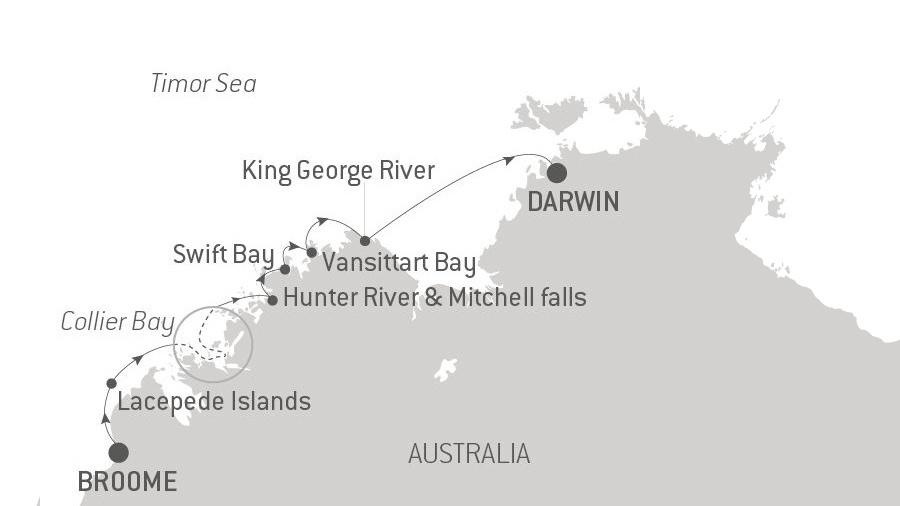
-
Exclusive Bonus Offer on all our cruises!
Receive 2 FREE nights accommodation + a FREE sightseeing tour
Is Le Laperouse by Ponant The Right Cruise Ship For You?
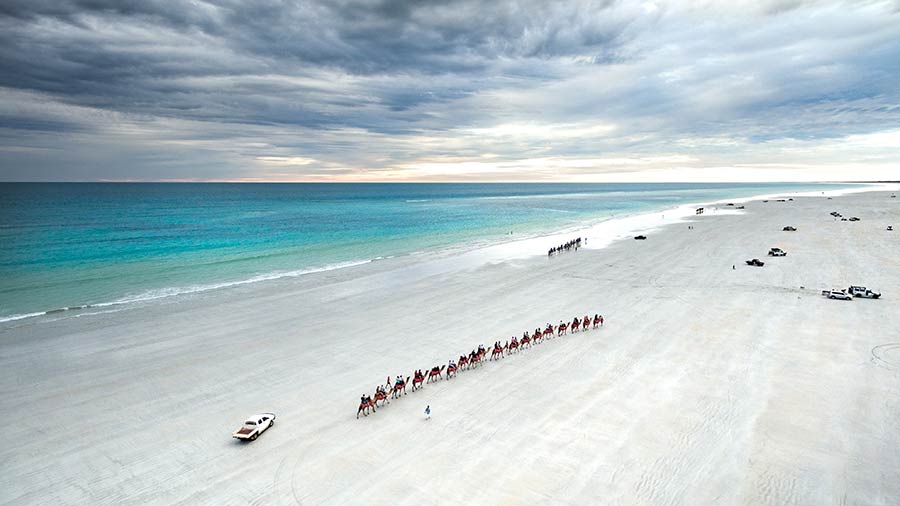
Day 1
Broome
Located in the northwest of the Kimberley region and in the far north of Western Australia, the town of Broome is reputed for its history and its glorious pearling era. The fascinating Chinatown district which is the historic city centre and the famous Japanese Cemetery, which dates from 1896, allows to discover the city’s past marked by the immigration of numerous Chinese and Japanese workers, attracted by the prosperous pearl industry at the end of the 19th century and at the beginning of the 20th century. Broome is also famous for the “Staircase to the Moon”, an optical illusion created by the Moon reflecting on the sand banks at low tide, like a staircase climbing up towards the sky, a unique spectacle provided by nature…
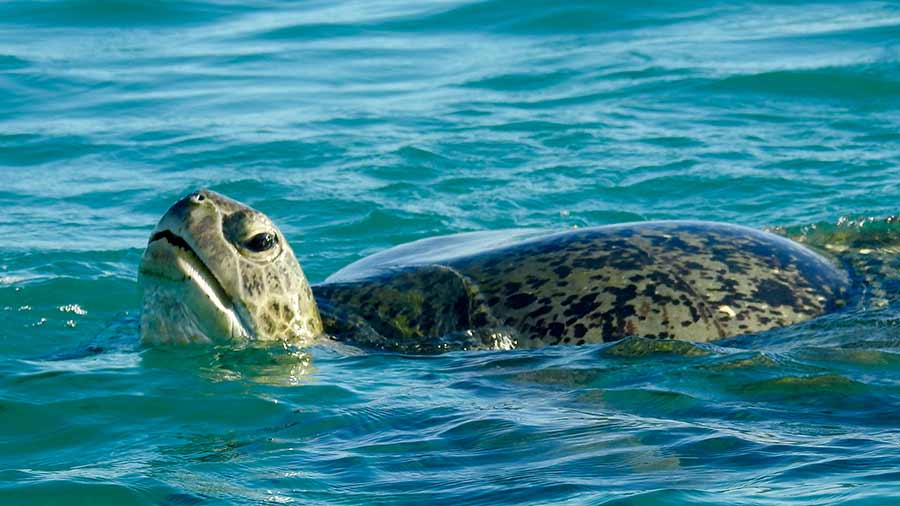
Day 2
Lacepede Islands
The Lacepede Islands are Western Australia’s most important breeding habitat for Green Turtles (Chelonia mydas), and have been named by BirdLife International as an Important Bird Area (IBA). The breeding colony of Brown Boobies is possibly the largest in the world. Up to 20,000 Roseate Terns have also been recorded here. Other birds breeding on the islands include Masked Boobies, Australian Pelicans, Lesser Frigatebirds, Eastern Reef Egrets, Silver Gulls, Crested, Bridled and Lesser Crested Terns, Common Noddies, Pied and Sooty Oystercatchers. Join your expedition team for a guided Zodiac® tour to view the prolific wildlife. Due to the sensitive nature of the environment, landings are prohibited on the Lacepede Islands.
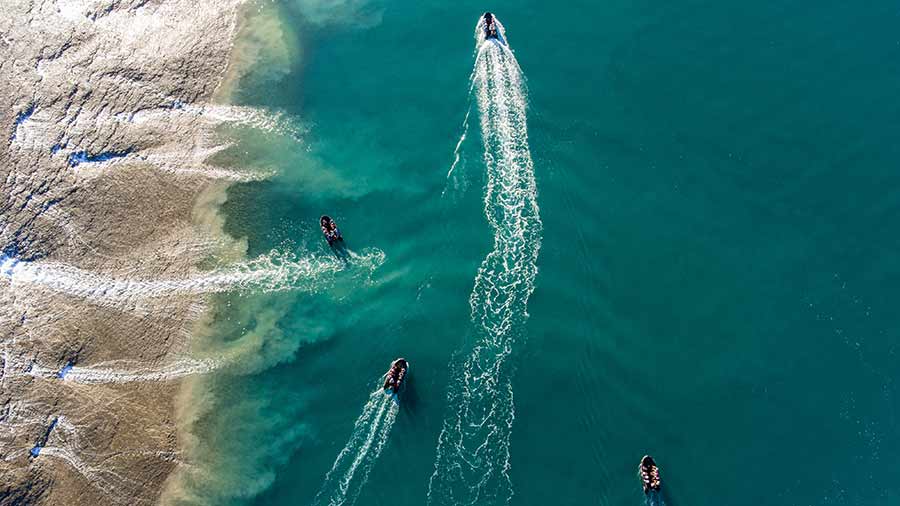
Day 3
Collier Bay
Collier Bay is located on the rocky and deserted coast of one of the most remote region of the Kimberley, that visitors can only approach by ship. The tidal movements, amongst the largest range of anywhere on the planet create amazing phenomena as seawater comes in or out: the “Horizontal Waterfalls”, a waterfall up to 4 metres high between the narrow passages of the vertiginous cliffs in Talbot Bay or Montgomery reef, a spectacular example of the impact of these tides cascading in mini-waterfalls as the entire reef appears to rise from the turquoise-blue waters of the bay. Containing large areas of shallow lagoon, seagrass beds and corals, Montgomery reef is Australia’s largest inshore reef.In this majestic landscape, you enter an aboriginal area. Some outstanding open air painted caves galleries alluding to their myths of creation can be observed after a hike on the hills. As we are at the mercy of weather and tide conditions in this region, the activities mentioned below are only possible experiences and can’t be guaranteed.
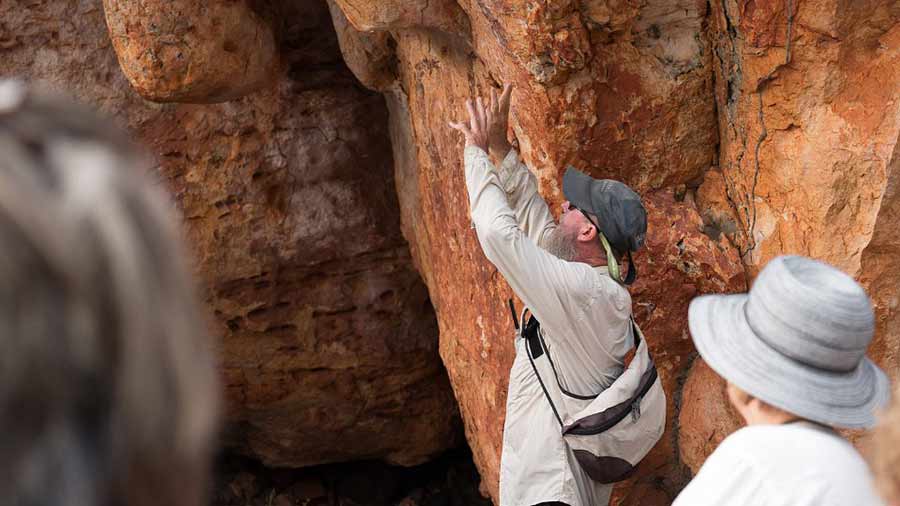
Day 4
Raft Point
Collier Bay is located on the rocky and deserted coast of one of the most remote region of the Kimberley, that visitors can only approach by ship. The tidal movements, amongst the largest range of anywhere on the planet create amazing phenomena as seawater comes in or out: the “Horizontal Waterfalls”, a waterfall up to 4 metres high between the narrow passages of the vertiginous cliffs in Talbot Bay or Montgomery reef, a spectacular example of the impact of these tides cascading in mini-waterfalls as the entire reef appears to rise from the turquoise-blue waters of the bay. Containing large areas of shallow lagoon, seagrass beds and corals, Montgomery reef is Australia’s largest inshore reef.In this majestic landscape, you enter an aboriginal area. Some outstanding open air painted caves galleries alluding to their myths of creation can be observed after a hike on the hills. As we are at the mercy of weather and tide conditions in this region, the activities mentioned below are only possible experiences and can’t be guaranteed.
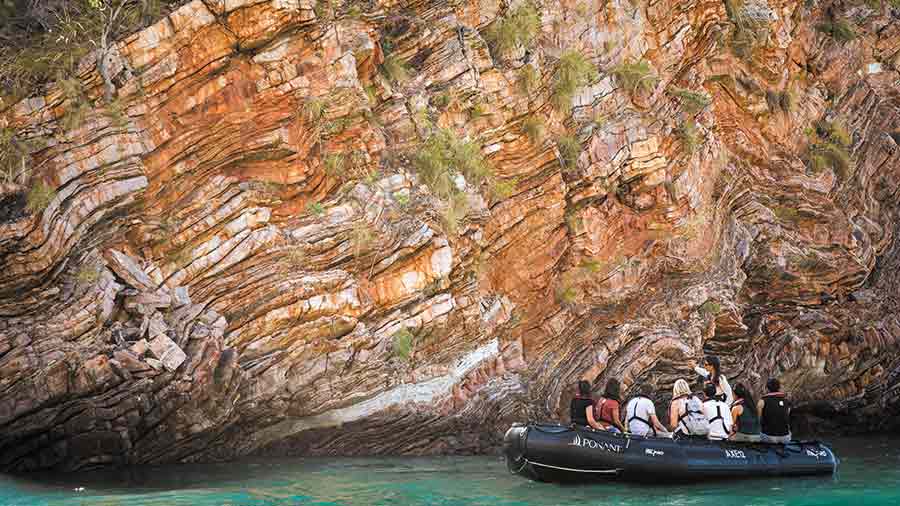
Day 5
Careening Bay
Careening Bay was named by Lieutenant Phillip Parker King after his ship, HMC Mermaid, was careened there during his third voyage of discovery in 1820. King surveyed the western coast to complete the map initiated by Flinders 20 years earlier. The Mermaid had been leaking badly and King needed to find a shallow sandy bay where he could careen his boat to undertake repairs. At a high tide, on a warm September afternoon, he ran the Mermaid onto the sands. For ten days the Mermaid crew worked hard before refloating the vessel. The ship’s carpenter carved the name of the vessel and the year into a conspicuous boab tree. The famous boab tree is now 3 metres wide and National Heritage listed. A reminder of a by gone era of exploration!
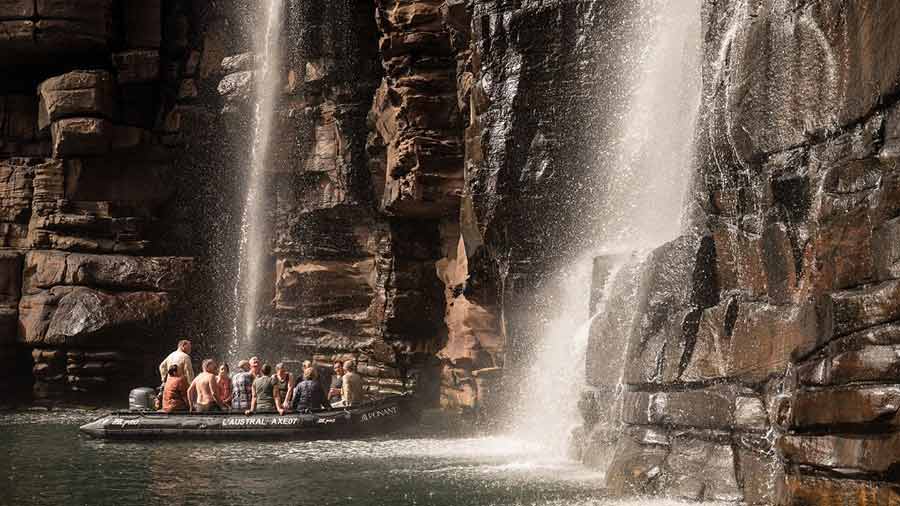
Day 6
Hunter River & Mitchell Falls
Arguably one of the most scenic parts of the Kimberley coast, Prince Frederick Harbour and the Hunter River are lined with ancient rainforest pockets, pristine mangroves and mosaic sandstone cliffs. They are considered to be some of the most pristine mangrove forests in the world, containing up to 18 different species, supporting a rich and diverse fauna. The sandstone escarpment at the river mouth, known as “Kampamantiya” rises over 200 metres high before giving way to extensive mud banks and mangrove forests home to numerous bird species and the iconic saltwater crocodile. Our expert Expedition Team will share their knowledge with you as you explore this pristine mangrove environment by Zodiac® keeping a constant lookout for wildlife.
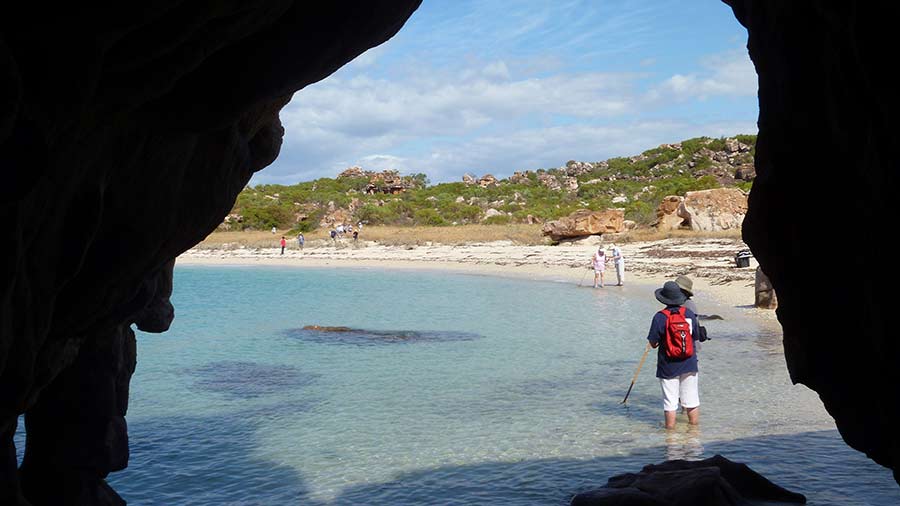
Day 7
Swift Bay
The Bonaparte Archipelago, is a stunningly rugged maze of islands stretching almost 150 km along Western Australia’s remote Kimberley coast. Its colour and scale conspire to take ones’ breath away. Its distant location has meant it has remained an unspoilt and remarkably pristine location to explore and experience. Phillip Parker King named “Swift’s bay” after Jonathon Swift (1667-1745) the author of Gulliver’s travels. The ‘T’ shaped bay is composed of heavily fractured sandstone providing an abundance of rock shelters. On the walls of these shelters are examples of both Wandjina and Gwion Gwion style rock art. Join your expedition team ashore for a guided walk to a number of rock art galleries depicting these unique rock art styles.
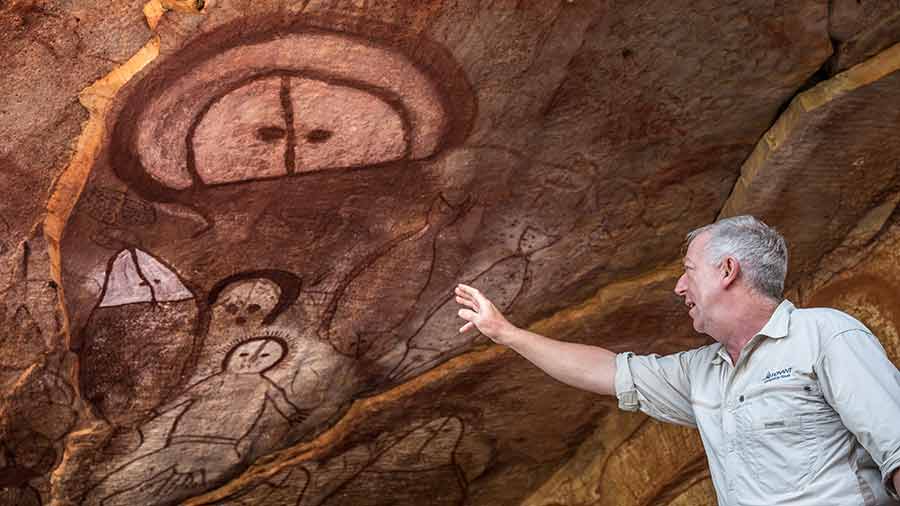
Day 8
Vansittart Bay
Jar Island contains ancient rock art galleries depicting the Gwion Gwion style unique to the Kimberley region. Mainly neglected by, or unknown to, the early European researchers of Aboriginal culture in the Kimberley in favour of the dominant and more dramatic Wandjina art, Gwion Gwion art has in recent years gained world prominence. It is generally thought that this art may extend back to over 30,000 years before our time and represents the first wave of seagoing colonisers of the Australian continent. As it is, these are the oldest detailed depiction of human figures in the world. Join your Expedition Team ashore for a short walk, past some fascinating rock formations, to the site of the Gwion Gwion art galleries.
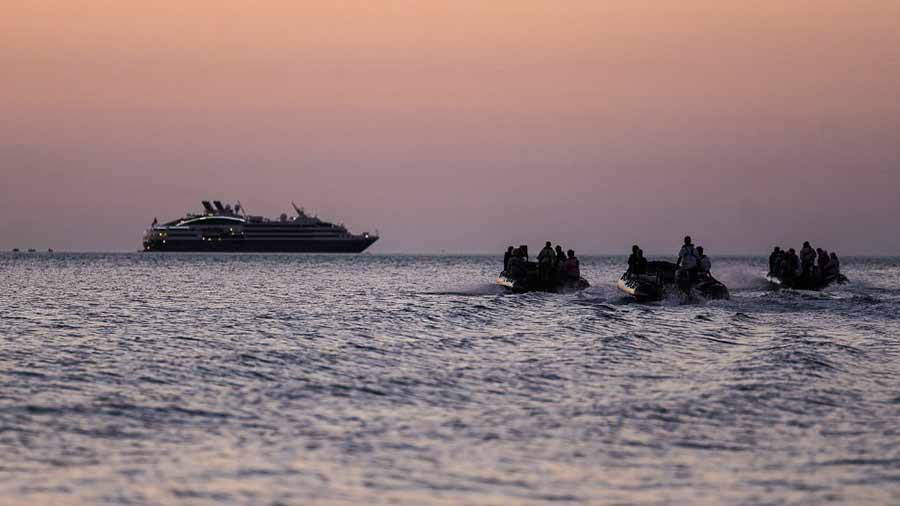
Day 9
King George River
The journey up the King George River is nothing short of breathtaking. The 80m high sides of the gorge display varying degrees of weathering of the ancient Warton sandstone. The colours and textures of the gorge change with the light as you travel further up the river creating a continual changing scenery that is simply stunning. The journey culminates at the King George twin falls; the highest single-drop falls in the whole of the Kimberley (80m or 260ft). Fed by wet season run-off the level of water cascading over the falls varies from year to year. Your Expedition Team will escort you in either the Zodiacs or ships tenders to the foot of the twin falls, and explain all about the stunning geological formations of the canyon.
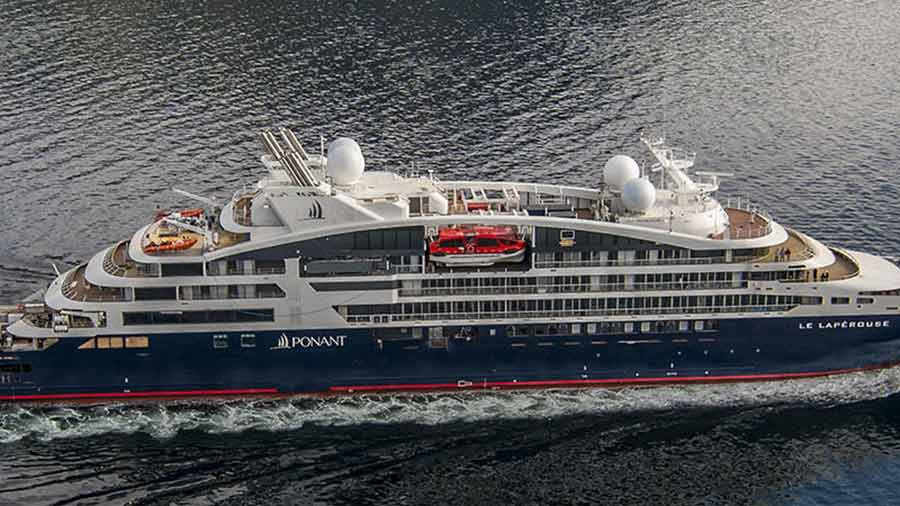
Day 10
At Sea
During your day at sea, make the most of the many services and activities on board. Treat yourself to a moment of relaxation in the spa or stay in shape in the fitness centre. Depending on the season, let yourself be tempted by the swimming pool or a spot of sunbathing. This day without a port of call will also be an opportunity to enjoy the conferences or shows proposed on board, to do some shopping in the boutique or to meet the PONANT photographers in their dedicated space. As for lovers of the open sea, they will be able to visit the ship’s upper deck to admire the spectacle of the waves and perhaps be lucky enough to observe marine species. A truly enchanted interlude, combining comfort, rest and entertainment.
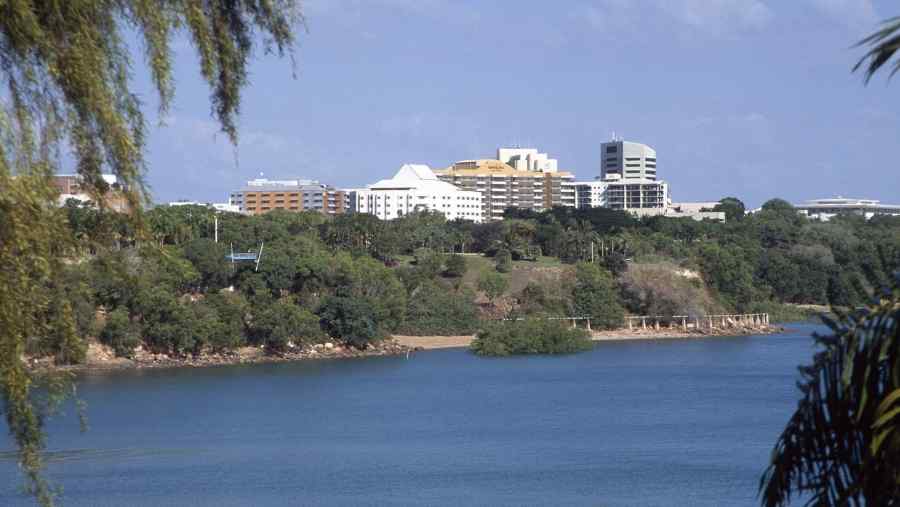
Day 11
Darwin
Darwin is located in Australia’s Northern Territory which is also known as the “Top End”. It is the capital city and the most populated town of the Northern Territory. Darwin is a beautiful tropical city, a melting pot of people and cultures, over 50 different cultures live and work side by side that prides itself in its unique and friendly laid-back lifestyle. Come discover the town’s still recent history through its emblematic buildings such as the new Parliamant House opened in 1994, a magnificent example of tropical architecture or Admiralty House declared heritage place, a tropical-style home elevated on stilts that has survived two cyclones and numerous air raids.
* All itineraries are indicative only. No two Kimberley cruises will be the same. Each cruise is tailored around the astounding 10+ metre tidal range, weather and sea conditions.
